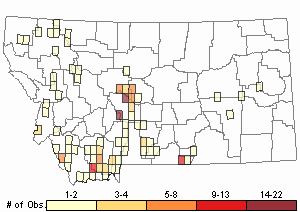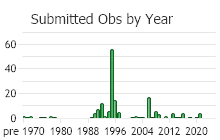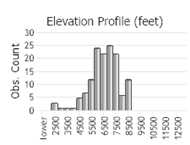View in other NatureServe Network Field Guides
NatureServe
Montana
Utah
Wyoming
Idaho
Wisconsin
British Columbia
South Carolina
Yukon
California
New York
Oniongrass - Melica bulbosa
Native Species
Global Rank:
G5
State Rank:
S4
(see State Rank Reason below)
C-value:
5
Agency Status
USFWS:
USFS:
BLM:
External Links
State Rank Reason (see State Rank above)
Melica bulbosa occurs scattered throughout central and western Montana.
- Details on Status Ranking and Review
Population Size
ScoreU - Unknown
Range Extent
ScoreF - 20,000-200,000 sq km (~8,000-80,000 sq mi)
Area of Occupancy
ScoreE - 26-125 4-km2 grid cells
Number of Populations
ScoreC - 21 - 80
Number of Occurrences or Percent Area with Good Viability / Ecological Integrity
ScoreC - Few (4-12) occurrences with excellent or good viability or ecological integrity
Environmental Specificity
ScoreD - Broad. Generalist or community with all key requirements common
Long-term Trend
ScoreU - Unknown
Trends
ScoreU - Unknown
Threats
ScoreU - Unknown
CommentThreats: Unknown/undetermined.
Intrinsic Vulnerability
ScoreC - Not intrinsically vulnerable
General Description
Plants: Bunchgrass. Stems 30–80 cm tall, often few-bunched, each from a bulbous corm base (Lavin in Lesica 2012), the bases clustered atop short thick rhizomes (Hitchcock et al. 1969).
Leaves: Sheaths smooth to slightly rough from short, thick hairs, the sheath completely encircling the stem for most of its length (Cronquist et al. 1977); ligules 2–6 mm in length (Lavin in Lesica 2012), strongly lacerate; blades plane to involute (Cronquist et al. 1977), the lower surface minutely roughened and the upper side hairy (FNA 2007), 2–5 mm in width (Lavin in Lesica 2012)
Inflorescence: A narrow panicle or raceme 10–30 cm long, the pedicels stiff, erect, mostly bearing 1 or 2 spikelets (Lavin in Lesica 2012).
Lavin's contribution adapted from Lavin in
Lesica et al. 2012. Manual of Montana Vascular Plants. BRIT Press. Fort Worth, TX)
Phenology
Flowering late May-August (Cronquist et al. 1977).
Diagnostic Characteristics
Melica bulbosa and
M. spectabilis appear similar and sometimes have spikelets ending in clusters of sterile florets. However, the glumes of
M. spectabilis are mostly < 1/2 the length of the spikelets.
M. bulbosa’s glumes are 1/2 to 2/3 as long or even equaling the spikelets (Lavin in Lesica 2012).
M. bulbosa also has purplish bands concentrated primarily near the tips of its spikelets. In
M. spectabilis, the bands are more evenly spaced (FNA 2007).
(Lavin's contribution adapted from Lavin in
Lesica et al. 2012. Manual of Montana Vascular Plants. BRIT Press. Fort Worth, TX)
Species Range
Montana Range
Range Descriptions

 Native
Native
Range Comments
Largely throughout and confined to the western half of North America (FNA 2007), including CO, WY and MT, west to CA and BC, staying mostly east of the Cascade peaks (Hitchcock et al. 1969).
Observations in Montana Natural Heritage Program Database
Number of Observations: 188
(Click on the following maps and charts to see full sized version)
Map Help and Descriptions
Relative Density

Recency



 (Observations spanning multiple months or years are excluded from time charts)
(Observations spanning multiple months or years are excluded from time charts)
Habitat
Montane to subalpine elevations on sagebrush inclines (Cronquist et al. 1977), dry meadows, rocky slopes and open understory (Lavin in Lesica 2012).
Lavin's contribution adapted from Lavin in
Lesica et al. 2012. Manual of Montana Vascular Plants. BRIT Press. Fort Worth, TX)
Reproductive Characteristics
Spikelets: 12–20 mm in length (Lavin in Lesica 2012), distantly spaced or overlapping (Hitchcock et al. 1969), jointed above the glumes and between the florets; glumes ovate, slightly rough with nerves scabrous occasionally, the first glume (5)6-8(9) mm in length and (1-)3-(4)-nerved, the second glume (6.5)7-9(11) mm in length and 5-(7)-nerved; lemmas (6)8-9.5(12) mm in length and (5-)9- to 11-(15)-nerved, rounded or broadly pointed, slightly rough, 4 to 7 per spikelet, awnless; paleas a little shorter than the lemmas (FNA 2007); anthers 2.5-3.5 mm in length (Cronquist et al. 1977).
(Lavin's contribution adapted from Lavin in
Lesica et al. 2012. Manual of Montana Vascular Plants. BRIT Press. Fort Worth, TX)
Stewardship Responsibility
References
- Literature Cited AboveLegend:
 View Online Publication
View Online Publication Cronquist, A., A. H. Holmgren, N. H. Holmgren, J. L. Reveal, and P. K. Holmgren. 1977. Intermountain flora: Vascular Plants of the Intermountain West, U.S.A. Volume 6: The Monocotyledons. New York, NY: Columbia University Press. 584 pp.
Cronquist, A., A. H. Holmgren, N. H. Holmgren, J. L. Reveal, and P. K. Holmgren. 1977. Intermountain flora: Vascular Plants of the Intermountain West, U.S.A. Volume 6: The Monocotyledons. New York, NY: Columbia University Press. 584 pp. Flora of North America Editorial Committee, eds. 2007. Flora of North America North of Mexico. Volume 24. Magnoliophyta: Commelinidae, Part 1. Oxford University Press, Inc., NY. xxxiii + 911 pp.
Flora of North America Editorial Committee, eds. 2007. Flora of North America North of Mexico. Volume 24. Magnoliophyta: Commelinidae, Part 1. Oxford University Press, Inc., NY. xxxiii + 911 pp. Hitchcock, C. L., A. Cronquist, M. Ownbey, and J. W. Thompson. 1969. Vascular Plants of the Pacific Northwest. Part I: Vascular Cryptogams, Gymnosperms and Monocotyledons. Seattle, WA: University of Washington Press. 914 pp.
Hitchcock, C. L., A. Cronquist, M. Ownbey, and J. W. Thompson. 1969. Vascular Plants of the Pacific Northwest. Part I: Vascular Cryptogams, Gymnosperms and Monocotyledons. Seattle, WA: University of Washington Press. 914 pp. Lesica, P., M.T. Lavin, and P.F. Stickney. 2012. Manual of Montana Vascular Plants. Fort Worth, TX: BRIT Press. viii + 771 p.
Lesica, P., M.T. Lavin, and P.F. Stickney. 2012. Manual of Montana Vascular Plants. Fort Worth, TX: BRIT Press. viii + 771 p. McGregor, R.L. (coordinator), T.M. Barkley, R.E. Brooks, and E.K. Schofield (eds). 1986. Flora of the Great Plains: Great Plains Flora Association. Lawrence, KS: Univ. Press Kansas. 1392 pp.
McGregor, R.L. (coordinator), T.M. Barkley, R.E. Brooks, and E.K. Schofield (eds). 1986. Flora of the Great Plains: Great Plains Flora Association. Lawrence, KS: Univ. Press Kansas. 1392 pp.
- Additional ReferencesLegend:
 View Online Publication
View Online Publication
Do you know of a citation we're missing? Ament, R.J. 1995. Pioneer Plant Communities Five Years After the 1988 Yellowstone Fires. M.Sc. Thesis. Bozeman, MT: Montana State University. 216 p.
Ament, R.J. 1995. Pioneer Plant Communities Five Years After the 1988 Yellowstone Fires. M.Sc. Thesis. Bozeman, MT: Montana State University. 216 p. Durham, R. A., D. L. Mummey, L. Shreading, and P.W. Ramsey. 2017. Phenological patterns differ between exotic and native plants: Field observations from the Sapphire Mountains, Montana. Natural Areas Journal, 37(3), 361–381.
Durham, R. A., D. L. Mummey, L. Shreading, and P.W. Ramsey. 2017. Phenological patterns differ between exotic and native plants: Field observations from the Sapphire Mountains, Montana. Natural Areas Journal, 37(3), 361–381. Lesica, P., M.T. Lavin, and P.F. Stickney. 2022. Manual of Montana Vascular Plants, Second Edition. Fort Worth, TX: BRIT Press. viii + 779 p.
Lesica, P., M.T. Lavin, and P.F. Stickney. 2022. Manual of Montana Vascular Plants, Second Edition. Fort Worth, TX: BRIT Press. viii + 779 p. Quire, R.L. 2013. The sagebrush steppe of Montana and southeastern Idaho shows evidence of high native plant diversity, stability, and resistance to the detrimental effects of nonnative plant species. M.Sc. Thesis. Bozeman, MT: Montana State University. 124 p.
Quire, R.L. 2013. The sagebrush steppe of Montana and southeastern Idaho shows evidence of high native plant diversity, stability, and resistance to the detrimental effects of nonnative plant species. M.Sc. Thesis. Bozeman, MT: Montana State University. 124 p.
- Web Search Engines for Articles on "Oniongrass"





